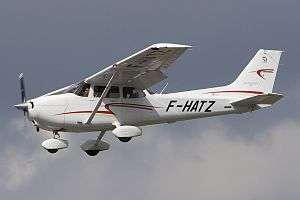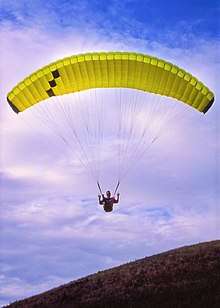General aviation
General aviation (GA) represents all civil aviation "aircraft operation other than a commercial air transport or an aerial work operation".[1]
.jpg)
Definition

%2C_Germany_PP1278146759.jpg)


The International Civil Aviation Organization (ICAO) defines civil aviation aircraft operations in three categories: General Aviation (GA), Aerial Work (AW) and Commercial Air Transport (CAT).[1][2] General aviation thus represents the 'private transport' and recreational components of aviation.[2] It also includes activities surrounding aircraft homebuilding, flight training, flying clubs, and aerial application, as well as forms of charitable and humanitarian transportation. Private flights are made in a wide variety of aircraft: light and ultra-light aircraft, sport aircraft, business aircraft (like private jets), gliders and helicopters.[2] Flights can be carried out under both visual flight (VFR) and instrument flight (IFR) rules, and can use controlled airspace with permission.
Aerial work operations are separated from general aviation by ICAO in its definition. These activities include agriculture, construction, photography, surveying, observation and patrol, search and rescue, and aerial advertisement. However ICAO has considered officially extending the definition of general aviation to include aerial work to reflect common usage and for statistical purposes.[3][1][2]
The International Council of Aircraft Owner and Pilot Associations (IAOPA) includes the following definitions for General Aviation aircraft activities:[2]
- Corporate Aviation: Company own-use flight operations
- Fractional Ownership Operations: aircraft operated by a specialized company on behalf of two or more co-owners
- Business Aviation (or Travel): self-flown for business purposes
- Personal/Private Travel: travel for personal reasons/personal transport
- Air Tourism: self-flown incoming/outgoing tourism
- Recreational Flying: powered/powerless leisure flying activities
- Air Sports: Aerobatics, Air Races, Competitions, Rallies etc.
The majority of the world's air traffic falls into the category of general aviation, and most of the world's airports serve GA exclusively.[4]
Geography
Europe
In 2003 the European Aviation Safety Agency (EASA) was established as the central EU regulator, taking over responsibility for legislating airworthiness and environmental regulation from the national authorities.[5]
United Kingdom
Of the 21,000 civil aircraft registered in the UK,[6] 96 percent are engaged in GA operations, and annually the GA fleet accounts for between 1.25 and 1.35 million hours flown. There are 28,000 Private Pilot Licence holders, and 10,000 certified glider pilots. Some of the 19,000 pilots who hold professional licences are also engaged in GA activities. GA operates from more than 1,800 airports and landing sites or aerodromes, ranging in size from large regional airports to farm strips.
GA is regulated by the Civil Aviation Authority (CAA). The main focus is on standards of airworthiness and pilot licensing, and the objective is to promote high standards of safety.
North America
General aviation is particularly popular in North America, with over 6,300 airports available for public use by pilots of general aviation aircraft (around 5,200 airports in the U.S., and over 1,000 in Canada[7]). In comparison, scheduled flights operate from around 560 airports in the U.S.[8] According to the U.S. Aircraft Owners and Pilots Association (AOPA), general aviation provides more than one percent of the United States' GDP, accounting for 1.3 million jobs in professional services and manufacturing.[9]
Regulation
Most countries have authorities that oversee all civil aviation, including general aviation, adhering to the standardized codes of the International Civil Aviation Organization (ICAO). Examples include the Federal Aviation Administration (FAA) in the United States, the Civil Aviation Authority (CAA) in the United Kingdom, Civil Aviation Authority of Zimbabwe (CAAZ) in Zimbabwe, the Luftfahrt-Bundesamt (LBA) in Germany, the Bundesamt für Zivilluftfahrt in Switzerland, Transport Canada in Canada, the Civil Aviation Safety Authority (CASA) in Australia, the Directorate General of Civil Aviation (DGCA) in India and Iran Civil Aviation Organization in Iran.
Safety
Aviation accident rate statistics are necessarily estimates. According to the U.S. National Transportation Safety Board, general aviation in the United States (excluding charter) suffered 1.31 fatal accidents for every 100,000 hours of flying in 2005, compared to 0.016 for scheduled airline flights.[10] In Canada, recreational flying accounted for 0.7 fatal accidents for every 1000 aircraft, while air taxi accounted for 1.1 fatal accidents for every 100,000 hours.[11] More experienced GA pilots appear generally safer, although the relations between flight hours, accident frequency, and accident rates are complex and often difficult to assess.[12][13][14]
A small number of commercial aviation accidents in the United States have involved collisions with general aviation flights, notably TWA Flight 553, Piedmont Airlines Flight 22, Allegheny Airlines Flight 853, PSA Flight 182 and Aeromexico Flight 498.
See also
- Associations
References
- "1. Definitions" (PDF). Annex 6, Operation of Aircraft Part I, International Commercial Air Transport – Aeroplanes (9 ed.). International Civil Aviation Organization (ICAO). July 2010. pp. 1, 3 and 5. ISBN 9789292315368. Retrieved 17 March 2019.
- "What is General Aviation; Definition". The International Council of Aircraft Owner and Pilot Associations (IAOPA). Retrieved 16 March 2019.
- "ICAO web site" (PDF). Retrieved 17 June 2020.
- iaopa.org, "What is GA?" Archived 20 December 2016 at the Wayback Machine. Retrieved 17 November 2012
- "5" (PDF). Strategic Review of General Aviation in the UK. CAA. July 2006. pp. 52–53, paras. 5.18–5.24. Retrieved 19 December 2016.
- "UK Registered Aircraft January 2010" (PDF). CAA. Retrieved 19 December 2016.
- Nav Canada: Canada Flight Supplement - Canada and North Atlantic Terminal and Enroute Data Nav Canada, 2010.
- FAA Administrator's Fact Book (PDF). U.S. Department of Transportation. March 2010. p. 16.
- AOPA USA's General Aviation website Archived 14 February 2015 at the Wayback Machine.
- "NTSB accident rates by flying category" (PDF). Ntsb.gov. Retrieved 19 December 2016.
- "Aviation Safety Program Manual for the Civil Aviation Directorate". Tc.gc.ca. 31 December 2015. Retrieved 19 December 2016.
- Knecht, WR (2012). DOT/FAA/AM-12/15 "Predicting general aviation accident frequency from pilot total flight hours" (Technical Report). Washington, D.C.: Federal Aviation Administration.
- Knecht, WR (2015). "The 'killing zone' revisited: Serial nonlinearities predict general aviation accident rates from pilot total flight hours". Accident Analysis & Prevention, 60, 50–56.
- Knecht, WR (2015). DOT/FAA/AM-15/3 "Predicting accident rates from general aviation pilot total flight hours" (Technical Report). Washington, D.C.: Federal Aviation Administration.
External links
| Wikimedia Commons has media related to General aviation. |
| Wikivoyage has travel information for General aviation. |
- International Aircraft Owners and Pilots Associations
- European General Aviation Safety Team (EGAST)
- "No Plane No Gain" website about business aviation